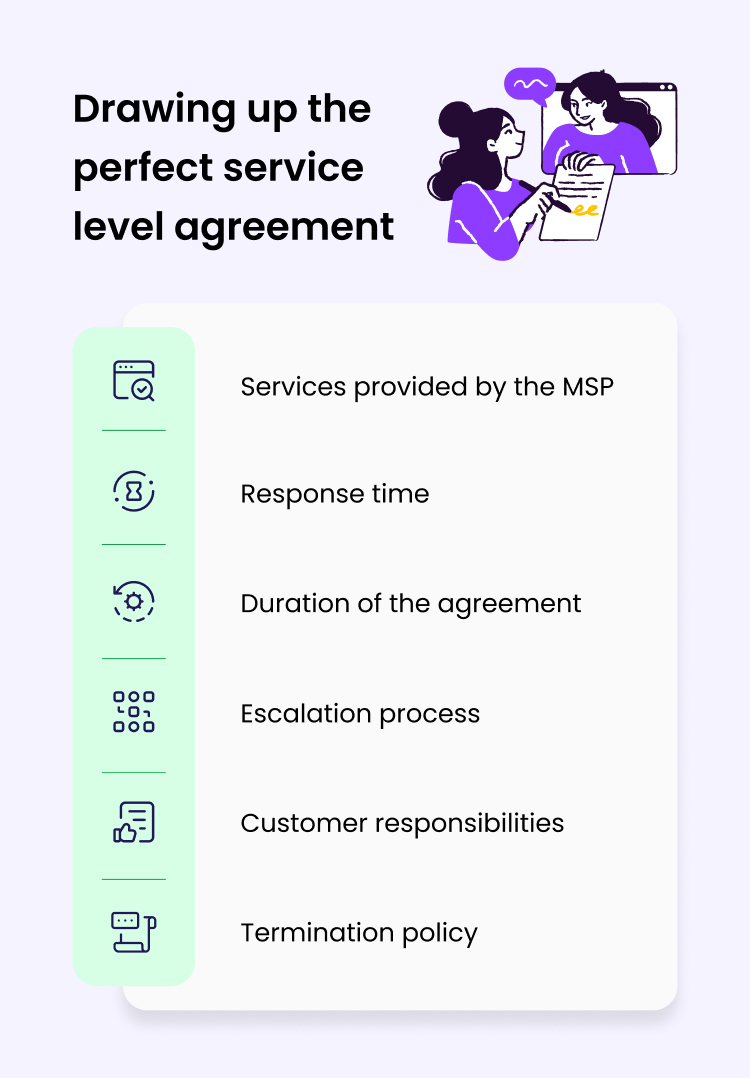Set your MSP apart with clear and measured Service Level Agreements you frame with your customers.
Why should SLAs be an important part of an MSP’s business negotiations?
Tech management is a vast field and MSPs are no exception to the constant diversification taking place here. In recent times especially, we have witnessed MSPs building differentiating businesses. Now, one of the main challenges with dealing with so many multiple verticals could be setting the expectation levels with your clients.
There are thousands of service providers that companies can choose from, but what sets you apart could be clear, measured Service Level Agreements or SLAs you frame with your customers.
What are service level agreements?
To put it simply, SLAs are an understanding of the services expected to be offered by the MSP to their clients. It sets the level of scope of work and the time taken to resolve an issue by the service provider. An effective SLA also makes sure that there are no obstacles in communication between the two parties. Both parties are aware of the expectation levels in terms of service set between them.
When you don’t have SLAs set in place, the confusion and ambiguity for both parties can become detrimental to business. Let’s take a further look at why it’s essential for MSPs to have a solid SLA in place.
Why should MSPs focus on concrete service level agreements:
- SLAs will help set the level of calibre for your MSP. It also reinforces the fact that you are serious about timelines and prompt service. It gives the customers a sense of security that their mission-critical requirements are being met at the right time.
- A good service agreement also mitigates the possibility of disagreements between the MSP and the customers. If a difference of opinion occurs then all the MSP has to do is check back with the SLA and inform the customers of the arrangement. It acts effectively as a security blanket for both parties keeping the responsibilities and rights all above board.
- Having a strong SLA set in place also prevents the backlog of open tickets from accumulating. If the service agreement states that a ticket has to be resolved in the predetermined time then the technician will prioritise the ticket to be closed within that window. For instance, SuperOps.ai has a very intuitive feature built within ticketing called Runbooks. Runbooks are a list of predefined processes that help the technician solve a repetitive issue. So if in your SLA, you have set a time window for closing a ticket then features like Runbooks help in further accelerating the ticketing process.
- A well-defined SLA will also have a clear-cut termination policy stated. This is so that if an eventuality occurs where the MSP and their client company are ending their contract then, there is no ambiguity over termination guidelines. For a process that could be a bit chaotic, SLAs will see to it that both parties can carry out their end of the agreement without a hitch
The perfect service level agreement should include the following:
1. Services provided by the MSP
An SLA at the outset should clearly define the type of service that is extended towards the client. This can include the levels of service packages and also what each package covers in terms of service.
2. Response time
Define the minimum time taken by the MSP to respond to a ticket. And once the ticket has been opened, the total time taken to resolve the issue and close it.
3. Duration of the agreement
Specify the time period of the agreement, review the agreement when it nears expiry, and renew with changes if required.
4. Escalation process
An SLA might have different processes and multiple levels of technicians answering the ticket. Escalations happen when the first response to the ticket doesn’t meet its agreed upon time and secondly when the resolution time taken to close the ticket exceeds its predetermined schedule.
5. Customer responsibilities
One of the primary obligations that the customer has to meet are timely payments made monthly or yearly.
6. Termination policy
The terms of termination between the MSP and the customer must be made in clear and uncomplicated fashion.

One of the most important factors of success for an MSP would be a successful relationship with their customer. And the easiest way to work towards that goal is to have an iron-clad service agreement in place. Creating a strong service agreement between both parties will help in smoothing out any confusion and disagreements that can arise in the future.
For an MSP, it is also crucial to maintain that harmonious relationship with their customers so that a happy customer renews the contract on expiry. For a customer too, having a clear understanding of where they stand with their expectations from their service provider gives them confidence that they are not being taken for a ride. Above all, a strong SLA helps in a smooth running of the system and organizational success for both the MSP and the customer.





